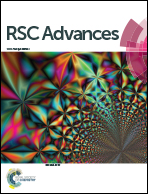Structure variations of a series of lanthanide complexes constructed from quinoline carboxylate ligands: photoluminescent properties and PMMA matrix doping†
Abstract
A series of lanthanide complexes with formulae {[KEu(Hqlc)(qlc)(H2O)6(OH)]2+·2Cl−}n (1·Eu), {[Eu(qlc)2(phen)(H2O)2]+·Cl−}·CH3CN (2·Eu), [Eu(qlc)2(phen)(NO3)]·H2O (3·Eu), [Ln(qlc)2(H2O)4]·(qlc)·(H2O) (Ln = Eu(4·Eu), Sm(5·Sm), Gd(6·Gd), Tb(7·Tb), Dy(8·Dy), Ho(9·Ho)) (Hqlc = quinoline-3-carboxylic acid, phen = 1,10-phenanthrolin) are synthesized under solvo(hydro)thermal conditions and characterized by single-crystal X-ray diffraction, infrared spectra, elemental analysis, and powder X-ray diffraction. Complex 1 exhibits two-dimensional (6,3)-connected hcb networks and possesses a stable structure through typical O/C–H⋯Cl intermolecular hydrogen bonds. Complexes 2–4 display three diverse dimer structures, due to the synergistic effect from coordination modes of Hqlc ligand and anion effect. Complexes 5–9 are isostructural with complex 4. Eu-complexes 1–4 could provide intense and bright characteristic 5D0 → 7FJ red luminescence under UV excitation in the solid state at 298 K and 77 K. In complexes 2 and 3, the coordinate phen ligand could play the antenna role in the energy transfer process. Therefore, the luminescence lifetimes of complexes 2 (779.62 and 792.65 μs) and 3 (947.21 and 1095.59 μs) are longer than those of complexes 1 (456.93 and 499.33 μs) and 4 (283.70 and 46 469 μs) in the solid state at 298 K and 77 K. Complexes 5, 7 and 8 exhibit characteristic Sm3+, Tb3+ and Dy3+ ion luminescence. Furthermore, through controlling the concentration of complexes 3 and 4 in poly(methyl methacrylate) (PMMA), a series of 3–PMMA and 4–PMMA hybrid materials are obtained, respectively. They all display strong and characteristic red luminescence emissions at a concentration of 8%. Compared with 3 and 4, the luminescence intensities and luminescence lifetimes of 3–PMMA and 4–PMMA are increased, due to the replacement of water molecules by PMMA.


 Please wait while we load your content...
Please wait while we load your content...